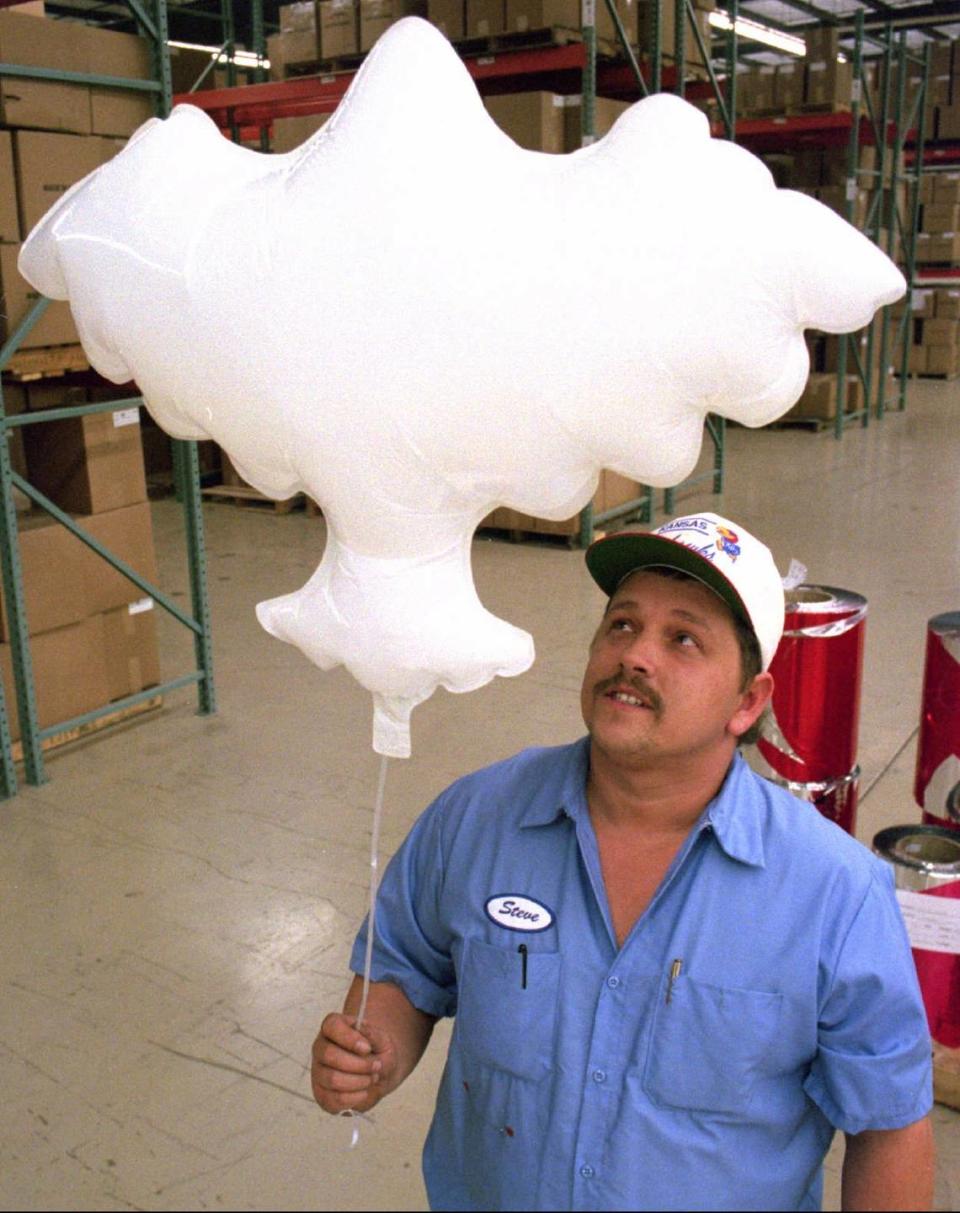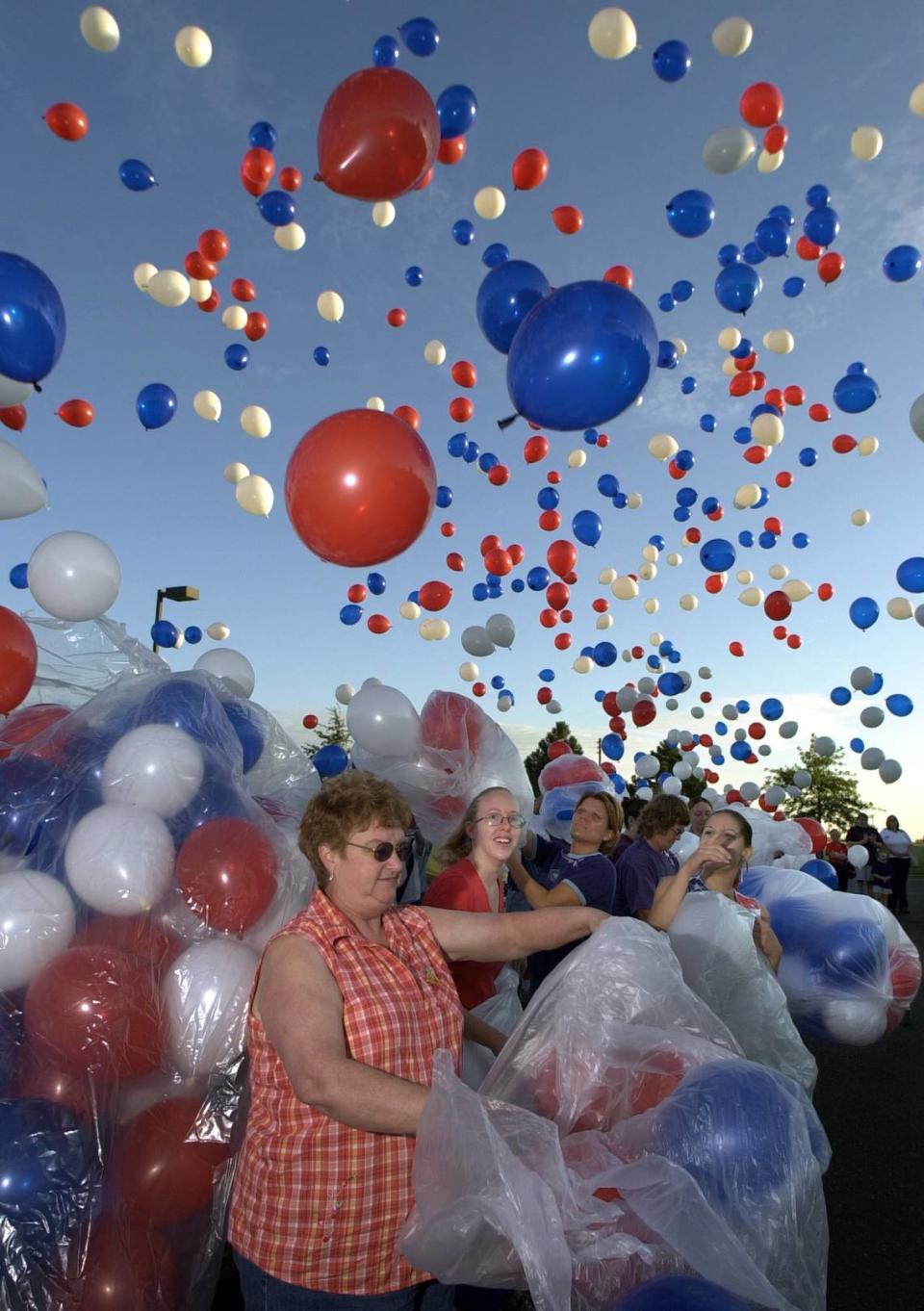Amid bankruptcy filing, Pioneer Balloon owners find cheer in ‘a huge, huge future’
There’s nothing cheery about a business declaring bankruptcy, but that’s not how Ted and Betty Vlamis are looking at the Chapter 11 filing of their Pioneer Balloon.
“We think the celebrations business has a huge, huge future,” Ted Vlamis said.
“We bring smiles to people around the world, and that’s a necessary element in today’s world. . . . To have a little bit of joy.”
There was no joy for the 106-year-old company — one of the largest balloon manufacturers in the world — during the pandemic, which Vlamis said is what led to the bankruptcy.
“It was devastating on us.”
Only the year before, Pioneer Balloon had its biggest year ever.
When the Vlamises bought the business and moved the headquarters to Wichita in 1979, gross annual sales were $2.5 million.
“We have grown the business tremendously since we took over,” Ted Vlamis said.
He won’t talk specific figures, but Vlamis said the business grew to 50 times its 1979 size by 2019. The math works out to about $125 million in sales.
“There was a lot of demand for balloons,” Betty Vlamis said.
With the pandemic, though, there were far fewer parties and events and much less demand for balloons. Sales dropped by more than 30%.
“It sounds like a small number until you realize what kind of profit margins you’re working with,” said David Prelle Eron, the company’s attorney.
He said it’s “the difference between making money and losing money.”
“If this had continued for 12 months, yeah, it wouldn’t have been a problem,” Eron said.
He said more than double that time was an issue because Pioneer’s reserves weren’t big enough to handle the losses.
Eron said there are different ways to consider the company’s assets and liabilities.
The overall company — Continental American Corp., which does business as Pioneer Balloon — declared Chapter 11 along with Ohio-based Pioneer National Latex, a subsidiary the parent company purchased in late 1999 and closed in late 2022 because “it was a very old facility, and it was not worth upgrading,” Ted Vlamis said.
Pioneer’s other five wholly owned subsidiaries, all of which are based outside of the United States, have not filed for bankruptcy.
Eron said grouping the parent company and its subsidiaries together, there are just over $66 million in assets and just over $36 million in liabilities, for a net equity position of $30 million.
The beginning
Pioneer started in Ohio in 1917 as Pioneer Rubber, and it produced latex balloons and gloves.
The company’s name reflected that latex comes from rubber trees in the equatorial belt around the world. Places such as Indonesia, Thailand, Malaysia, Africa and Guatemala.
In 1970, Sherwood Medical Group acquired Pioneer primarily for its glove division.
Ted Vlamis said Sherwood tried to run the balloon division the same as it did its medical products.
“It did not work.”
The Vlamises had been in the food business but got out and were looking for a new business when Sherwood decided to sell the balloon side of its company in 1979.
“Maybe we could make a decent business out of it,” Ted Vlamis said he and his wife thought.

With 85 employees at an Ohio plant and four employees in Wichita, including themselves, the Vlamises set out to reposition the brand.
“It had essentially no marketing behind it,” Ted Vlamis said.
Part of the acquisition included Qualatex, a balloon brand name that was established in 1935 and became “known as the very best balloons around the world,” Ted Vlamis said.
The company kept the same formulations but no longer touted its balloons for children only. Ted Vlamis said the strategy was to market balloons for everyone, “Because we all have a bit of a kid in us.”
Education became another strategy, and Vlamis said it’s been a hallmark of what the company has done since the 1980s.
There are “one heck of a lot of small entrepreneurs,” he said.
Vlamis said he and his wife saw a way to make money “if we could teach people how to make money on selling balloons.”
The professional market is Pioneer Balloon’s biggest customer. That includes balloon artists, event planners and retailers.
“We are also quite a large printer of balloons,” Ted Vlamis said.
Pioneer does custom printing for a lot of companies that want their logos or names on balloons.
In 1993, Pioneer started the Qualatex Balloon Network, an educational curriculum for anyone who works with balloons.
“That gives us a tremendous base,” Vlamis said. “If we can teach people how to make money by selling balloons, we can get a fair share of their business.”
The company started adding plants. It kept the Ohio plant until 1996 and then in 1999 purchased another balloon company there — the one that’s now in bankruptcy.
In addition to plants in El Dorado and Dallas, the company has operations in the United Kingdom, Canada, Mexico, Brazil and Australia. It also has a 28-acre headquarters at 29th North and Oliver, across from the Hughes Metropolitan Complex.
Half of Pioneer’s business is domestic, and half is international.
The company produces more than a billion or maybe even two billion balloons a year, Vlamis said. He said it’s a little hard to say because some are 3-foot balloons and then there are small balloons, “which we do by the zillions.”
‘Any and all possibilities’
At the beginning of the pandemic, Pioneer had to close its prime plants for 10 weeks.
Though it received money from the government to help cover employee costs during that time, Ted Vlamis said, “We lost a lot of employees that were with us for many, many years.”
Some employees retired, and some preferred what they could make through what Vlamis called government handouts.
“The whole labor situation since COVID has been very different,” Vlamis said.
He said it takes months to teach employees how to run equipment to produce balloons.
“The training of employees is crucial,” Vlamis said. “It takes us over an hour to make one balloon. That may surprise you”
The labor situation finally has improved.
“It’s taken us time to work our way back . . . from the ravages of COVID,” Vlamis said.
Now that that’s happening, he said, “That’s why we’re so optimistic about the future.”
He said the company is modernizing its equipment, adjusting wages and seeing its training pay off.
“We have put all of our resources in terms of making sure we plug all of the areas that need fixing,” Vlamis said.
Now, it’s seeking partnerships for future growth.
“We’re open to any and all possibilities,” Vlamis said.
That could mean taking on investors, operating partners or possibly even selling the business.
“The company has a tremendous heritage,” Betty Vlamis said.

Ted Vlamis said “with that kind of strong background, we can attract partners that can be helpful.”
With its heritage and what Ted Vlamis called its stellar reputation and educational approach, he said it’s “an attractive combination to people who have foresight of what can be done with a very simple product that brings joy.”
Pioneer Balloon has 900 employees worldwide today.
“We desperately want to see them do super well,” Ted Vlamis said.
For them, he said, “We’re committed to making sure that this business has a tremendous solidarity to its future.”
“What we’re really focused on is really the future,” Betty Vlamis said. “We’re very upbeat about the future.”
Eron said he’s in awe of Pioneer Balloon, which does business “on every populated continent on the planet.”
“Just the incredible reach and impact of this company that is kind of nestled over there on 29th and Oliver, it’s just kind of cool.”

